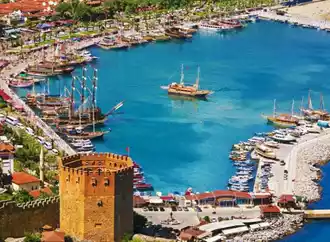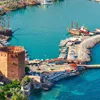Located at an altitude of 850 meters above sea level, the Ancient City of Laertes was founded on a chest-shaped hill. It is approximately 25 kilometers from Alanya.
Located at an altitude of 850 meters above sea level, the Ancient City of Laertes was founded on a chest-shaped hill. It is approximately 25 kilometers from Alanya. Today, it is in a place close to Gözü Küçüklü Village. The ancient city, which is within the borders of the region known as Rough Cilicia in ancient times, is an ancient city with a harbor although it is in the interior.
Agora, exedra, bath, cisterns, theatre, houses and temples belonging to Emperor Claudius, Apollo, and Zeus Megistos are important ruins that have survived from the ancient city to the present day. No remains belonging to the Hellenistic period were found in the ancient city of Laertes. This is due to the fact that the region was in the hands of pirates at that time, and therefore, the construction activities could not be carried out.
However, a stone inscription found in Laertes proves that the history of the city dates back to ancient times. B.C. The stone inscription, which is thought to belong to the 6th century and has some local names on it, is currently exhibited in the Alanya Museum. In the stone inscription in question, there is some information about the servant of the provincial governor and the property of the period. There is also a necropolis to the south of the ancient city of Laertes. Here, too, there are many ostetek (Ostetek; the name given to the container where the ashes are placed after the corpses of the deceased are burned.) and the pedestals on which the osteteks stand.
Among the ruins of the Roman Period in the city, watchtowers, semi-circular seating in the agora, the imperial street, the odeon or the theater, temples built in the name of Zeus, Apollo and Caesar can be counted. The city lived its brightest periods from the 1st century to the 3rd century AD. A diploma belonging to a soldier found during excavations sheds light on life in the past. NS. In the document, in which the name of the Governor of Pamphylia is mentioned in 138 AD, it is written that a Syrian soldier was discharged after twenty-five years of honorary service and he was given Roman citizenship and the right to marry a Pamphylian woman. The other documented inscription found in Laertes is the inscription of a Roman soldier, which will shed light on the military aspect of the city.
Both inscriptions can be seen in the exhibition area of Alanya Archeology Museum. NS. HE. The Phoenician inscription from the last quarter of the 7th century proves the existence of Laertes before the Roman Imperial Period.
The structures of the ancient city that have survived until today are worth seeing. Buildings that have existed for so many years allow you to travel in history. It will be a tremendous experience to know that there are people who lived in the same place years ago and to learn about their lives. With its history dating back to BC, the Ancient City of Laertes continues to welcome its visitors with its structures still standing.
Translated by Google Translate










.webp)

.webp)




















